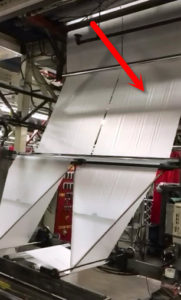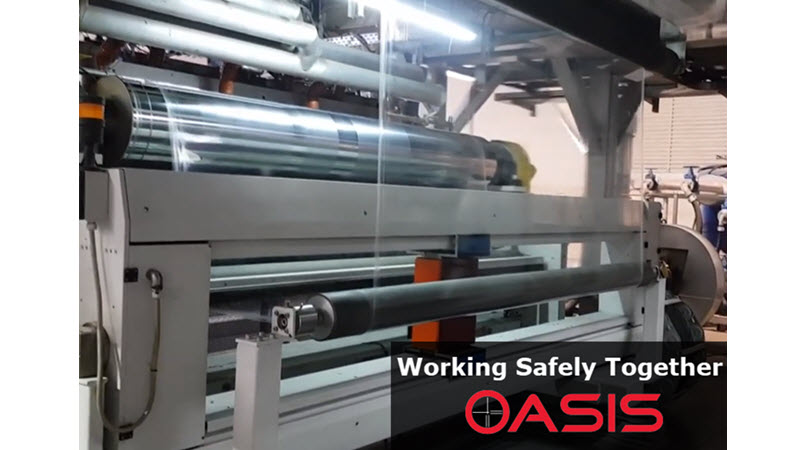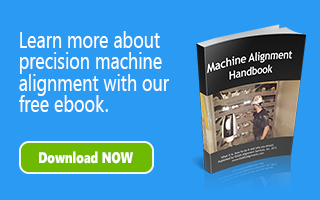In order for plastic film manufacturers – blown film or cast film – to obtain the greatest benefit from the alignment of their machine components, it is best to understand how alignment effects the entire process line – from gearbox, feed throat, barrel, and screw through the downstream equipment. Misalignment of any of the components in a film line can have a direct impact on operational efficiency and product quality. In this post, we discuss the causes of misalignment and the alignment related issues that can occur within the process line. We also provide an overview of alignment methods for correcting these issues and the benefits of a properly aligned film production line.
Misalignment Causes
There are several causes of misalignment that are the same across most types of manufacturing – especially those that are web-based. Components within production lines will typically become misaligned over time due to normal events such as equipment wear and corrosion, vibration, and building and/or frame movement and settling.
Other misalignment causes include improper alignment at initial installation, and a lack of alignment support during component repair or replacement, and during equipment modifications and rebuilds. These are issues that can be avoided by taking a proactive approach to the alignment of your equipment.
Precision alignment should be included as part of any machine or component installation plan, and as part of your preventative maintenance programs – especially with the tighter tolerances required by most film lines. Establishing the machine’s centerline and installing a baseline during line installation creates a permanent reference to which all future alignment inspections are measured. Additionally, a verification survey completed during installation produces an ‘as built’ drawing of installed alignment conditions that can be used as a reference for future inspections.This allows for quick identification of issues and faster turnaround for corrective alignment adjustments, resulting in a reduction of costly unplanned downtime. Note that machine centerline surveys and baseline installations can (and should) also be performed on existing machines, no matter how long they have been in production.
Extruder Barrels & Screws
If you are seeing an increase in energy consumption, one of the first areas to inspect is the alignment of the extruder barrel to the gearbox. Misalignment will not only generate higher energy expenditure, but accelerate the wear of the barrel and the screw. One of the main factors in achieving optimum efficiency, is the proper alignment of the rotational center of the screw to the rotational center of the gearbox thrust shaft. If these components are not aligned, excessive contact may result between the screw and barrel leading to premature barrel and screw wear, increased clearance, decreased through-put, back-flighting, surging, and even screw breakage.
For an in-depth look at the importance of extruder barrel alignment as well as extruder alignment methods, and preventative maintenance and troubleshooting procedures, please visit: Extruder Barrel Alignment is Essential to Plastics Extrusion Process
Downstream Equipment – Blown Film & Cast Film
Though there are distinct differences in the manufacturing processes of blown film and cast film, precision alignment of all components that make up the web path is critical to producing the highest quality film. All plastic film manufacturers, no matter the process, want to avoid sheet defects such as wrinkling, shrinking or stretching, baggy edges, and tension problems. Precision machine alignment can help reduce and even eliminate many of these issues.

An example of wrinkling due to roll misalignment
In blown film lines, there are several areas that when misaligned, can cause poor product quality. In addition to extruder alignment, it is also important to inspect the center of the nip rolls to the center of the die. Nip rolls need to be level and parallel to each other and with a rotating nip, they need to stay level as they rotate. Misalignment of the die with the fixed roll in the haul-off can cause the film to shrink or stretch in multiple directions resulting in non-uniform product. Additionally, if the rolls in any given section are out of alignment, the results are often the dreaded wrinkling, baggy edges, and tension issues. For example, transverse wrinkles are most often the result of several rolls not only being misaligned, but out of level or square to the process centerline in the direction of the sheet travel. The recommended approach to reduce product issues, is to perform a full alignment survey of the line from the haul-off through the rewind in order to determine the relationship of each unit to the best fit process centerline as well as, determine the level and square attributes of critical rolls in each part of the process. For additional information specific to blown film line alignment, please visit: How to Identify and Correct Alignment Issues in Blown Film Lines.
Manufacturers of cast film products will typically see the same alignment related product issues occur when the rolls in the web path are misaligned. In cast film lines however, in addition to maintaining proper alignment of the extruder(s) and the downstream rolls, the alignment and positioning of the die to the casting device (casting roll/chill roll/quenching roll) is essential. The die and roll should be parallel in both the vertical and horizontal attributes. Additionally, the geometry of the angle of die orientation to casting device as well as the height of the die to casting device is paramount to obtaining proper sheet formation.
To allow for cleaning and maintenance during machine down times, most – if not all – cast film lines have a machine configuration arrangement where the die frame assembly can be “unlocked” and moved away from the casting device section (usually in cross machine direction) and the casting device section frame assembly can be “unlocked” and moved away from the die (in the machine direction).
It is imperative that either section be properly aligned when “locked in place” in the operational position AND that the proper alignment condition be maintained and/or repeatable each time the sections are moved and then returned to operational position. Additional components of these assemblies such as ways or tracks in the floor, casters on the die and/or cast section frames and stops, must also be considered during inspection and alignment.
The Benefits of Precision Machine Alignment – A Real-World Example
A large manufacturer of plastic film products began receiving feedback from several of their customers stating that the final product did not meet their quality standards. The engineering group at this facility, hired OASIS to perform a thorough inspection of the components within the line in order to determine if misalignment was the cause of the quality issues. Using optical alignment tooling, the OASIS team performed an initial alignment survey of the rolls in the line. This inspection found that the overall alignment of the rolls was acceptable, however there was significant misalignment at the unwind and rewind turrets, as well as in the accumulator. OASIS worked with the team from this location to develop a plan to address the major alignment concerns.
The plan involved having OASIS perform a complete alignment of the line using optical alignment tooling and the mechanical capabilities of an OASIS large tool crib/truck. A seven-person OASIS team was able to complete this project in one 10-hour shift. This project resulted in improved film tracking and a substantial quality improvement that now met their customers’ stringent requirements.
As the global health crisis continues due COVID-19, many plastic film manufacturers are working non-stop to produce essential products for the healthcare and food and beverage industries. We thank you for all that your doing and are available to you if and when issues arise within your process lines. Know that we are working safely and are diligently following CDC and WHO guidelines. Please contact us if you need help in the coming weeks. Stay safe and healthy.

